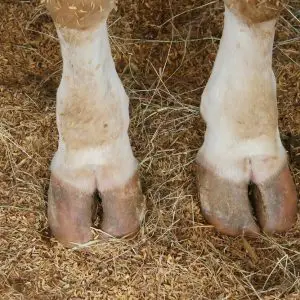Chicken feet for dogs are becoming increasingly popular as owners are seeking out natural, healthy treats for their dogs. In fact, they’re not only popular for dogs, but they are somewhat of a delicacy for humans too in many parts of the world. Nevertheless, for some, they are just a bit too life-like. So why are these tasty, yet rather creepy-looking treats so popular? How will they benefit your dog? And are they truly safe?
In this article we will unpack all the pros and cons of chicken feet, as well as answer some common questions about them. So, keep reading to find out more about this treat your dog is sure to love!
Key facts
Chicken feet can provide your dog with some excellent health benefits for their joints and teeth.
They are a wonderful natural treat, and are available in several different forms to suit individual dogs and owners.
They should be avoided if you have a young puppy, or a dog allergic to chicken. But if not, then your dog is sure to love giving them a try.
What are Chicken Feet?
There are no prizes for those who can guess what animal and anatomical part chicken feet come from! The feet of chickens are often a wasted part of the body of slaughtered chickens, so repurposing them into dog treats certainly ensures nothing goes to waste.
Chicken feet for dogs can be bought in several different forms.
Raw Chicken Feet
These can be bought straight from the butcher as off-cuts or at your local farmer’s market. They might be fresh or frozen, but regardless which they are, they have had no processing at all. This means they need a thorough clean before giving to your dog. While you can dehydrate raw chicken feet at home for your dog, you can also give them fresh or frozen too.
Dehydrated Chicken Feet
These are cleaned, dehydrated in a dehydrator and packaged before you buy them. They have a long shelf-life of over six months (not that your dog will allow them to last that long). They are usually yellow in colour, and slightly shrivelled-looking in comparison to the raw form of the feet.
Puffed Chicken Feet
These are similar to dehydrated chicken feet; however, they are air-dried which means they retain more vitamins and nutrients in the drying process. They are usually whiter in colour than dehydrated feet, and retain their shape better, or even look a little puffed up.
Benefits of Chicken Feet for Dogs
Chicken feet are highly nutritious for dogs. They have two main health draws to them; they help manage joint conditions, and they help maintain dental hygiene.
Key benefits
Dental Health
The crunching action of chewing through a chicken foot helps clean your dog’s teeth.
Joint Health
Chicken feet contain glucosamine and chondroitin which are both associated with good joints.
Joint Health
Chicken feet contain high concentrations of glucosamine and chondroitin, which are commonly found in canine joint supplements. These provide the building blocks for joint cartilage, and therefore help improve overall joint health for arthritic dogs, or dogs with joint conditions such as hip dysplasia. So, if you are looking for a natural alternative to joint supplements, it’s worth giving chicken feet a go! It’s been suggested that each foot is packed with approximately 450mg of glucosamine. In comparison to an average joint supplement, that’s a daily dose for a medium-sized dog!
Dental Health
Another major health benefit is the wonders they do for your dog’s teeth. While chicken feet might leave your dog’s breath smelling a little funny for a short time after eating, the crunching action through the feet helps to clean the teeth. This is due to the mild abrasion it creates on the outer enamel that scrapes away built-up left-over food and plaque. It’s important to note that no treat outweighs the benefit of actually brushing your dog’s teeth daily, but if you struggle for time, or are not great at remembering to brush, giving your dog a chicken foot will help you feel a little less guilty about it.
Nutrition & Compounds
Feeding Guide
A small dog can have one a day, and a larger dog can have two. Don’t expect them to hang around long! While it might take a smaller dog up to 15 minutes to crunch their way through it, a larger dog is likely to finish it rather quickly.
Approx 75 Calories per Foot
Chicken feet are mainly composed of skin, tendons, cartilage and tiny bones, which means they contain very few calories compared to processed commercial or meaty treats.
Remember, though, that even healthy treats count as food going into your dog. So if you give them a treat, remove a little food from their daily meals to account for it.
Are Chicken Feet Safe for Dogs?
A Very Safe Treat
So long as they aren’t cooked, chicken feet present very few risks. The nails can be sharp, so if they haven’t been trimmed you may want to do that. But if your dog is fit and healthy, these treats should not cause any problems.
Beware Cooked Chicken Feet
Most dog owners have heard the advice ‘NEVER give a dog cooked chicken bones’, and so understandably, chicken feet might make you feel nervous. Cooked chicken bones are prone to splintering and causing blockages, which can lead to life-threatening gastrointestinal complications.
However, chicken feet are not cooked. They are either raw, dehydrated or puffed. This means the bones are crunchy and crumbly, and as a result, as your dog munches through the treat, the bones crush rather than break or splinter.
Watch Out for the Nails
The only part of the chicken feet which might cause a problem is the nails. They can be sharp and harder to digest than the other parts of the foot.
Sometimes, dog treat manufacturers trim off the nails in the preparation process, but if not, you might want to consider doing that yourself. A quick snip with some kitchen scissors easily removes them. Many dog owners do not worry about them if they are short though. With that being said, all dogs should be supervised when eating a treat for the first time to ensure there are no issues.
Unsuitable for Some Dogs
Naturally, obese dogs on a diet should not be fed treats, as even though chicken feet are healthy, a dieting dog should stick to their kibble alone.
In addition to this, dogs who are prone to pancreatitis may want to avoid chicken feet, as fat can cause a flare-up of the condition, which is highly unpleasant for your dog.
Finally, some dogs are allergic to chicken. For these dogs, chicken feet will not be suitable. Similar alternatives are available though, and so fear not, there is a solution. We will talk about these later on.
Chicken Feet for Puppies

Since chicken feet require some ability to crunch through them, it is advised that young puppies are not given chicken feet. This will help prevent damage to their developing teeth and the risk of unchewed food being swallowed.
Some people suggest that puppies can start having chicken feet from four months old when they begin losing their baby teeth and their adult teeth make an appearance. While chomping on a chicken foot will help with the discomfort of teething, it is better to wait until their adult teeth have fully come through, which is around the age of seven months. This prevents accidental, permanent damage to the teeth.
Alternatives to Chicken Feet
Do you like the idea of chicken feet, but not quite sold? There are several other treats which may do the job which you might want to consider.
- Dental chews: If you’re interested in chicken feet to help improve your dog’s dental hygiene, but can’t stomach something so real-looking, dental chews might be a viable option. They are specially shaped to clean your dog’s teeth and achieve fresh breath. The downside is that they are not natural products and often are high in calories.
- Duck feet: Duck feet are a wonderful alternative to chicken feet if your dog is allergic to chicken, yet you still want the benefits of the high glucosamine and chondroitin for joints. Duck is a novel protein and it’s often the case that dogs with food allergies can manage it very well with no reactions. However, unfortunately they can me much harder to source, and are also higher in fat, which means dogs who are overweight or struggle with bouts of pancreatitis should avoid them.
- Pig ears: These are another winner when it comes to a natural product which is excellent for teeth. Much like chicken feet, pig ears help to keep the teeth healthy due to your dog’s chewing action on the product. They are also predominantly full of cartilage and skin, much like the make-up of chicken feet. However, they are high in fat, and therefore should never be given to dogs who are overweight, or who suffer from pancreatitis. They are also smellier and greasier than chicken feet.
- Chicken necks: Much like chicken feet, chicken necks can be bought raw or dehydrated, and are made up of a similar nutritional composition too. This includes the high levels of glucosamine and chondroitin. So, they are an excellent alternative. The only downside is that the bones are a little more prominent in chicken necks, so if you worry about your dog forgetting to chew and running into complications, these might not be for him.
- Rabbit ears: If natural is what you’re after, rabbit ears are a great alternative. They are excellent for your dog’s teeth, and don’t smell or leave greasy stains. They can be found dehydrated or air-dried to preserve the nutrients. They are also a little lower in fat than chicken feet, and supposedly take longer for a dog to finish too. They often come with hair on though, which some people praise as a natural dewormer, but for many people, it can be a little creepy.
FAQs
Chicken feet are highly nutritious for dogs. They have two main health draws to them; they help manage joint conditions, and they help maintain dental hygiene.
The only part of the chicken feet which might cause a problem is the nails. They can be sharp and harder to digest than the other parts of the foot. Dogs who are prone to pancreatitis or that are allergic to chicken should probably avoid chicken feet.
Whether or not you get an unpleasant batch of chicken feet can be a hit or miss. It very much depends on how they are prepared as well as a bit of luck. Puffed chicken feet are usually non-greasy and not particularly smelly either. Fresh chicken and dehydrated chicken feet can be anywhere from greasy and smelly, to the other end of the spectrum as well.
It is always worth reading the reviews and details for any chicken feet you buy, as then you know what you’re likely to be getting.
However, the most unpleasant thing about them is their general appearance. They are completely natural (which is a good thing), but for some people, it might be just a little too close to a real live chicken for their comfort.
Although some people give chicken feet to teething puppies, it is better to wait until their adult teeth have fully come through (around the age of seven months). This prevents accidental, permanent damage to the teeth.
Chicken feet are generally not associated with diarrhoea in dogs who have healthy guts, as they are not overly rich or meaty. However, any new treat should be introduced gradually, especially for dogs with sensitive guts. It is worth noting that salmonella can be an issue when animals have been reared or processed in unsanitary conditions. If you always wash fresh chicken feet before feeding them and source them from places you trust, diarrhoea is highly unlikely to be an issue.
Chicken feet tend to crumble and crush when they are chewed, so they are no more likely to cause a blockage than normal dog kibble. The fact they contain bones may be off-putting, however the bones are tiny, and since they are never subjected to a cooking process, they do not become hard or brittle.
Chicken feet are not directly harvested for the purpose of treats. They are simply an off-cut from the chicken meat industry. They are usually destined for dog food, or disposable waste. You can even buy a ‘bin bag’ from your butcher, which often contains chicken feet that would have otherwise been thrown away. It is important to do your research when buying chicken feet though, as not all chicken feet will have come from free-range or ethically farmed chickens.
Once opened, dehydrated and puffed chicken feet can be stored in an airtight container in a cool cupboard. They will then last approximately six months. Fresh chicken feet need to remain in the fridge or freezer, and used within the time frame you would cook fresh or frozen chicken for yourself.
So long as you decrease the amount you feed your dog, you can give chicken feet to them every day if you want. Don’t feed a small dog more than one a day though (two per day for a larger dog).
Chicken feet are not a long lasting treat for dogs. They’re more like a snack. Don’t expect them to last more than a few minutes (probably 15 at the most).









